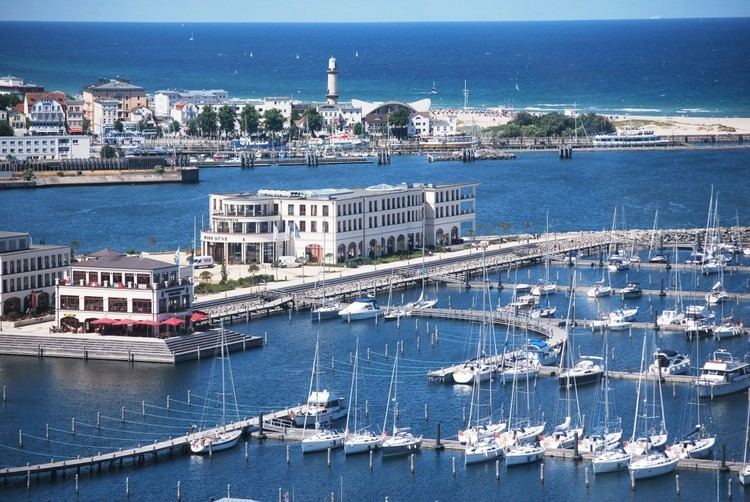 | ||
Yachting refers to the use of recreational boats and ships called yachts for sporting purposes. Yachts are different from working ships mainly by their leisure purpose.
Contents
- Competitive sailing
- Other yachting events
- Non yachting use of watercraft
- Cruising yachting as a lifestyle
- References
Both terms originate from the Dutch word jacht ("hunt"). With sailboats, it is called sailing, and with motorboats, it is called powerboating.
Competitive sailing
The invention of sailing is prehistoric, but the racing of sailing boats is believed to have started in the Netherlands some time in the 17th century. Soon, in England, custom-built racing "yachts" began to emerge. In 1851, the Royal Yacht Squadron in Cowes challenged the American yacht America. The race took place in the Solent. The America won the race and took the trophy, the America's Cup, back to the US where, held by the New York Yacht Club, it remained until 1983. The cup was then lost to the Royal Perth Yacht Club of Australia, which entered the Australia II into the contest. Meanwhile, yacht racing continued to evolve, with the development of recognised classes of racing yachts, from small dinghies up to huge maxi yachts.
Although there are many different types of racing vessels, they can generally be separated into the larger yachts, which are larger and contain facilities for extended voyages, and smaller harbour racing craft such as dinghies and skiffs. Smaller boats are not generally referred to as yachts, although all recreational boats (as opposed to commercial or military vessels) are yachts. These days, yacht racing and dinghy racing are common participant sports around the developed world, particularly where favorable wind conditions and access to reasonably sized bodies of water are available. Most yachting is conducted in salt water, but smaller craft can be raced on lakes and even large rivers.
Dinghy races are conducted on sheltered water on smaller craft with crews of between one and three people. The common arrangement for racing boats is the sloop, a boat with one mast. Some dinghies have only one triangular sail, but most have two configured as a sloop; some dinghies and almost all larger racing boats carry a spinnaker, a large, bulging sail designed for sailing "with the wind." Most races are conducted between vessels of identical design ("one design" racing). In these races, with identical equipment the sailors best able to make use of the ambient conditions win.
Dinghy designs vary from small, stable, and slow craft for novice sailors to lightweight, high-speed designs that are very difficult for even experienced crews to sail safely and effectively. Australia's 18-foot skiff class are the fastest monohull dinghies, reaching speeds of up to 40 kilometres per hour (25 miles per hour) even in relatively light winds. Sailing has a reputation for being a boring spectator sport, but skiff racing can be very exciting, particularly in unpredictable conditions where crews struggle to keep their boats upright. Various multi-hull racing classes are even faster. Various one-design dinghy classes are raced at the Summer Olympic Games.
Larger yachts are also raced on harbours, but the most prestigious yacht races are point-to-point long distance races on the open ocean. Bad weather makes even finishing such races a considerable test of equipment and willpower, and from time to time boats and sailors are lost at sea. The longest such events are "round-the-world" races which can take months to complete, but better-known are events such as the Fastnet race in the United Kingdom and the Sydney to Hobart Yacht Race along the east coast of Australia. Large races are usually organized with a first-past-the-post trophy (called "line honours") and under a handicap system that adjusts finishing times for the relative speeds of the boats' design, theoretically offering each entrant an equal chance.
Other yachting events
While sailing groups organize the most active and popular competitive yachting, other boating events are also held worldwide: speed motor boat racing; competitive canoeing, kayaking, and rowing; and navigational contests (generally a test of celestial and landmark-based navigation skills where GPS and other electronic navigation equipment is disallowed) are among the events which are organized around the world. Specialized yachts, such as hydrofoils, hovercrafts, or personal watercrafts also engage in competitions involving test of equipment and skill (usually, skill in maneuvering safely). All such events are part of the larger world of yachting, if they are done for recreational or sporting purposes.
Non-yachting use of watercraft
Common commercial uses of watercraft, which would not be referred to as yachting, include commercial fishing, shipping, operation of ferries, and military applications. In these cases, larger vessels are referred to as ships, smaller vessels as either ships or boats, although boat is a generic term that could be applied to a recreational yacht or a commercial or military vessel of smaller size.
Cruising - yachting as a lifestyle
Cruising involves traveling on a boat, whether across a bay, on the Great Lakes (in the US) or from island to island in the South Pacific. Safe cruising across long distances requires a degree of self-sufficiency and a wide range of skills beyond handling the boat. Knowledge of topics such as navigation, meteorology, mechanical and electrical systems, radio, first aid, sea survival, nutrition and more are needed and can be life saving when cruising to distant shores. In the US, the United States Power Squadrons offer courses and certifications in these skills. In the UK, a system of certification is run by the Royal Yachting Association. Similar systems are offered by organizations in other countries and typically include a range of courses, both theoretical and practical.
